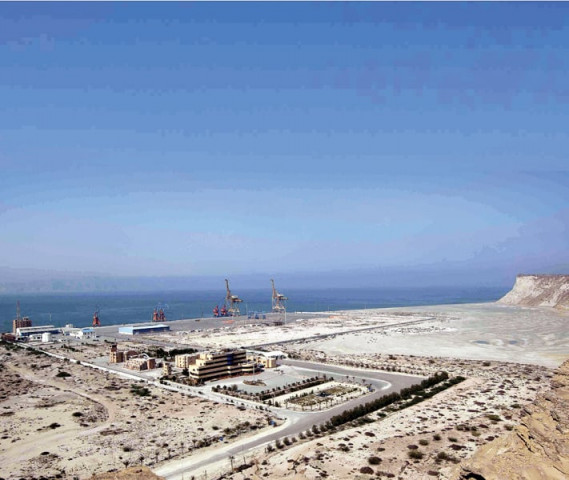Waiting on providence
In Gwadar, infrastructure and amenities are still a pressing need.

Three berths have been completed at Gwadar Port. PHOTOS: HALIMA MANSOOR
Public image, public relations
The press kits handed out on the plane had pages on PNS Darmaan Jah, the first hospital to be established in Ormara, along with other colleges and clinics. Once we were in Balochistan, however, it was hard to focus on the black and white.

Navy jetty in Gwadar. PHOTOS: HALIMA MANSOOR
On the tarmac at Ormara airport, it is hard to imagine that between the unyielding azure sky and sea rests a wasteland of hope. Its breathtaking beauty is articulated by undulating slaty expanses, bordered by slivers of bright blue waters.
One wonders why the area has not yet been transformed into a tourist destination, till realisation settles in the form of a lack of transport system, public transport, utilities, markets or mere signs of life. Driving through Ormara, everything seems still or untouched.
Day one of the development tour began at Jinnah Naval Base, Pakistan’s second largest naval unit, with a PowerPoint presentation and the remainder of the day was spent visiting the various talking points. Day two had similar tours of health units and schools in Jiwani and Gwadar and a five-minute view of the strategic port from a distant cliff.
Development goggles
Giving locals access to the navy’s schools and hospitals can be seen as a positive development in the absence of basic governance, infrastructure and amenities. There are roughly 500 students in the Bahria School in Ormara, where navy personnel can ‘adopt a child’ in terms of funding an academic year. “We need support, that’s why we develop the area,” commented Coast Commander Rear Admiral Arifullah Hussani.

A ration shop subsidised by the Navy. The building looming over is PC Gwadar which suffers many teething problems, shared hotel industry old timers. Without a developed town, there is little incentive to keep staff employed or to ensure a five-star service. PHOTOS: HALIMA MANSOOR
The people in question, however, were by and large invisible. Signs of life were only evident along the coastal highway in Gwadar, where the business of fishing and boat-making give the area a quiet energy. Even in places like the navy’s handicraft centre in Ormara, the only women visible were the sailors’ wives. Local women stay at home where navy shuttles drop sewing material. The end product is sold at bases to raise funds, but how much of that money sees its way back is a question left answered.
The towns are divided between the haves and the have-nots. “The government and ministry of defence paid the locals their asking price,” Hussaini claimed when asked about compensating the original settlers. But with no relocated families in sight, it is hard to confirm the same.

Along the Makran Coastal Highway. PHOTOS: HALIMA MANSOOR
In a virtual no-man’s-land, the navy has the capacity to build its oasis, replete with imported electricity, roads, water and even kitschy red chandeliers in mess rooms. Locals, however, are still dependent on the government to provide them basic facilities and, according to Commander West (ComWest), Commodore Naghman Chaudhry in Jiwani, they are getting more upset with each passing day. Their electricity runs sporadically on diesel generators which help supply towns like Jiwani. Living in a province replete with resources, the Makran coast has no running gas. In the absence of potable water, even fresh water wells with less than ideal PH levels are welcome resulting in all year round skin and gastro diseases, shared medical officers at health units.
Game of ports
Pervez Musharraf gave the nation high hopes over the development of Gwadar Port. A hub of trade and prosperity was projected using mock-ups of urban development mirroring modern day Dubai. Unfortunately, a more apt parallel would have been a picture of Dubai in the ’70s.
Currently in phase one, Gwadar Port has three shipping berths with 20 more expected to be constructed after a vast expanse of sea is reclaimed, shared Commander Zakir Khan, the director of the Directorate of Public Relations for the Navy. With China as a partner, the port is expected to provide a new strategic energy and military sea corridor, if completed. According to Naghman, the navy has put everything on a plate and offered it to the Chinese, to make the port a reality and the rest has to be done by the government. Previous partners, the Port of Singapore Authority, pulled out after the government failed to facilitate the development of a free trade zone.

Miles of barren expanses of land en route to Gwadar. PHOTOS: HALIMA MANSOOR
The success of the port and the prosperity of the coastal towns are interlinked. One cannot happen in the absence of the other, yet locals remain marginalised. Two days after the junket was over, Prime Minister Nawaz Sharif announced $1.6 billion for the socio-economic development of Balochistan. Let us hope that the money will translate into prosperity for the province.
Published in The Express Tribune, Sunday Magazine, April 27th, 2014.


















COMMENTS
Comments are moderated and generally will be posted if they are on-topic and not abusive.
For more information, please see our Comments FAQ